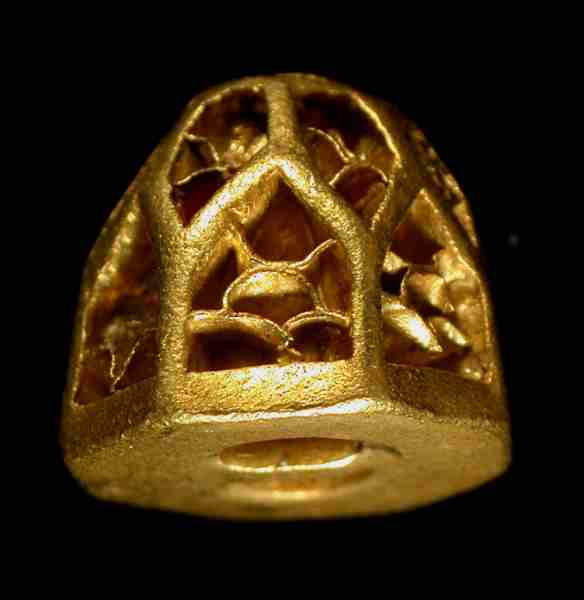TREASURE
H M Coroners have jurisdiction to inquire into any Treasure which is found in their districts and to establish who the finders were. Locally we have seen a huge increase in the amount of Treasure being found. It was thought at one time that the Island held little history in the shape of finds being recovered. Since the advent of metal detecting and specialized clubs on the Island, treasure is being recovered all the time and the Island is becoming a centre of National Historic Interest.
The Portable Antiquities Scheme
The Portable Antiquities Scheme is a voluntary scheme for the recording of archaeological objects found by members of the public. The Scheme was established to promote the recording of chance finds and broaden public awareness of the importance of such objects for understanding our past.
The Portable Antiquities Scheme was initially formed in 1997, and became Nationwide throughout England and Wales in 2003. Over 105,000 finds have now been recorded on the Scheme’s website database www.finds.org.uk. It is now funded by the Heritage Lottery Fund, which provides approximately £2.5 million towards the scheme.
The heart of the Scheme is its network of Finds Liaison Officers, who have a role in publicising the Scheme, record reported finds, give advice on finds recording, conservation and the Treasure Act and encourage liaison between members of the public, metal detector users, archaeologists and museums.
Anyone wishing to have an archaeological find identified may leave it with Frank Basford at the Archaeological Service where it will be identified and recorded on the Portable Antiquities Scheme website database. Only finds pre-dating 1700 are normally recorded, however some later finds of local interest can also be recorded.
All finds are usually returned to the finder or depositor after about two weeks, at which time a report is provided on each object that has been recorded. Occasionally illustrations are made of finds. In this case the finder is given a copy of the illustration.
Finders are credited with their discoveries and the locations of the finds are always treated in confidence.
| Anglo Saxon Gold “Pyramidal” Sword Belt Fitting found at Bembridge, Isle of Wight The Isle of Wight has long been noted for the rich grave goods found in the Anglo Saxon cemeteries of Bowcombe Down and Chessell Down, which date back to the Island’s pagan past in the sixth century AD. Now an important new Anglo Saxon find has been discovered in Bembridge Parish. This item of Treasure, a gold sword belt fitting, was found on 22nd September 2002, by Darren Trickey, using a metal detector. The British Museum has provided a technical report on the sword belt fitting for the Isle of Wight Coroner. Details of the find, given below, are taken from the British Museum report. The sword belt fitting is the most elaborate piece of metal-work or jewellery to have been found on the Island since the excavations at Bowcombe and Chessell in the nineteenth century. The gold fitting has an octagonal base and is decorated with sixteen panels divided into cells. Originally these cells were inlaid with garnets, only one of which now survives. At the base of the fitting is a bar through which a leather strap would have been threaded. The British Museum has dated the find to the seventh century AD. We know that in the seventh century the pagan Jutes came under the political domination first of the South Saxons and then of the West Saxons, whose king Caedwalla “laid waste Kent and the Isle of Wight” in AD 686, according to the Anglo Saxon Chronicle. The eighth century historian, the Venerable Bede, credits Caedwalla with converting the local Jutish population of the Isle of Wight to Christianity. If this is the case, his conversion methods sound rather drastic! According to the Anglo Saxon Chronicle, however, the Island had accepted Christianity some twenty five years earlier when it was first ruled by the South Saxons. We cannot date the sword belt fitting more specifically than to say it is seventh century date - nor can we be certain that it belonged to an Island resident. As it was found on the beach it may have been dropped by someone visiting (or even invading) the Island. We can be confident, however, that its owner was of very high rank, as the sword was the weapon worn by men of wealth and position in Anglo Saxon society. The Bembridge sword belt fitting is particularly fine and its octagonal form makes it a unique example of such an item. These fittings were generally made of either copper-alloy or silver but the Bembridge example belongs to a small high-status group made of gold or gold sheet, one of which comes from the seventh century royal ship burial at Sutton Hoo in Suffolk. We can thus make certain assumptions about the owner of the Bembridge sword belt fitting although his identity will always remain a mystery.  Frank Basford Finds Liaison Officer & Coroner’s Officer Isle of Wight Archaeology & Historic Environment Service 17 August 2003 01983 823810 [email protected] |
Page last updated on: 25/04/2006





